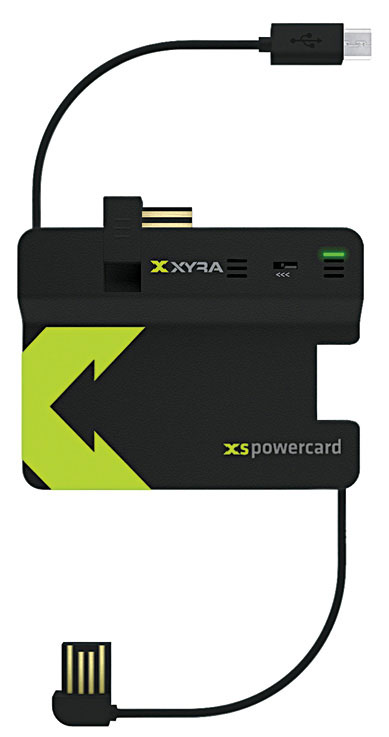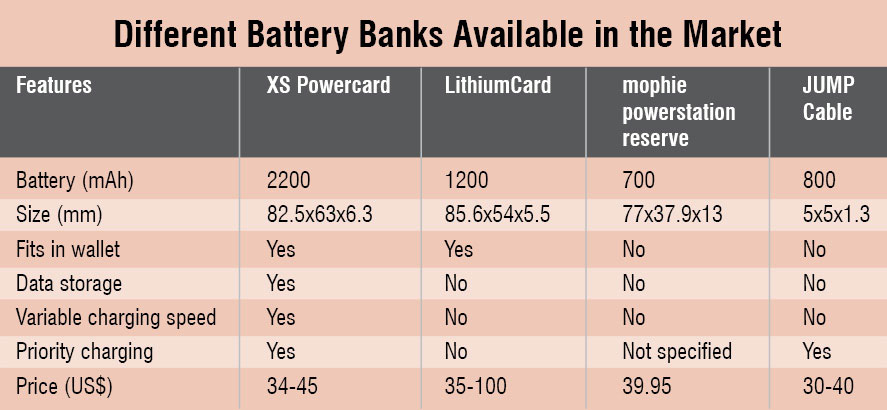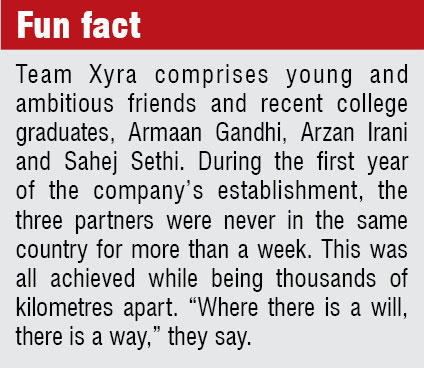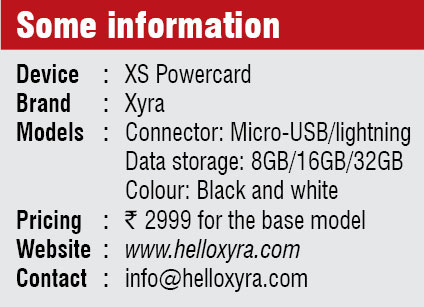 With smartphones getting smarter, their battery consumption is also increasing. Normally, a person has to charge a phone at least twice daily. But this becomes a headache when travelling, as the user may not find charging points everywhere, or have the time to wait till the phone is completely charged. That is why power banks got introduced, to charge the device on-the-go. However, many power banks available in the market today are bulky.
With smartphones getting smarter, their battery consumption is also increasing. Normally, a person has to charge a phone at least twice daily. But this becomes a headache when travelling, as the user may not find charging points everywhere, or have the time to wait till the phone is completely charged. That is why power banks got introduced, to charge the device on-the-go. However, many power banks available in the market today are bulky.
Would it not be great to have a power bank that is portable, stylish and has some cool additional features, too? To address this, Xyra, an Indian start-up, has come up with a new product called XS Powercard—a fashionable credit-card-sized gadget that easily fits into a wallet/purse, has built-in cables and detachable flash storage, and can transfer or synchronise data between the phone and a computer. It comes with variable charging speeds and priority charging, too.
Most of us do not leave the house without our phone and wallet. The proposition of the developers is ‘Do not forget your wallet and you will not forget your battery pack.’
Packed with features
This power bank, combined with storage and syncing functions, offers variable charging rates, three colours of light emitting diodes (LEDs) to indicate different charging states, three modes of charging (charge the phone, charge itself, and charge both), two types of connectors, a fortified universal serial bus (USB), autonomous phone detection and 2200mAh battery.
XS powercard has the following circuit blocks: DC-to-DC converter, logic circuit, lithium-ion battery recharging circuit, charge-rate modulation circuit and USB enumeration circuit.
It runs on a built-in non-replaceable 2200mAh lithium-polymer battery, encapsulated in two plastic halves that are ultrasonically welded together with other electronics in the circuitry. The battery lasts for over 500 cycles and has 150 days standby time until discharge.
Miniaturising the product
XS Powercard is 82.5×63.0x6.3mm in size and weighs just about 65gm. The body is made of ten per cent glass-filled polycarbonate, has smooth matte finish and comes in white and black colour variants.
Strategic casing design. It has an ergonomic and lightweight design that fits into a wallet, effectively using the existing space above the credit cards in it. That is, you can place the gadget in the topmost credit card slot with other credit cards stacked below it, and it adds only 6.3mm thickness to the wallet.
Cables are placed strategically to avoid tangling and measure up to 30.5cm (1-foot) when extended to their full length. Moreover, it allows the user to talk or text on the phone even while charging.
Eliminating switches. The smart power-management feature automatically and instantly detects and starts charging the phone when connected to the card. This eliminates the need for an on/off switch.
PCB size and space management. It was mainly critical thinking, intricate design choices and immaculate space management that allowed fitting everything into the small size, according to the team.
The team also spent a lot of time trying to miniaturise the printed circuit board (PCB) to the smallest size.
Charging smartly
XS Powercard combines multiple features that make charging easier and hassle-free for users.
Single-port smartcharging. The single-port charging allows users to simultaneously connect XS Powercard to the phone and USB port of a computer, laptop or adaptor. The team made it smart by introducing priority charging, which means that, when the gadget is connected to both phone and USB port, power is first directed to the phone, allowing it to charge. Once the phone is fully-charged, the gadget redirects power to charge itself. So you do not have to separately charge the two. This is ideal for those who charge their phones every night, as they can wake up to find both the devices charged.

Following is how it was implemented:
Current drawn by the phone was measured and calibrated to understand when it is completely-charged. Then, this system was hardwired into the device. The same could have been achieved with software as well but the team decided to take the hardware route as it was cheaper.
Variable charging rates. The device has a mechanical toggle switch that lets you select between two modes of charging. In standard mode, the phone is charged efficiently with 0.55A current. In other words, all of Powercard’s power is utilised to charge the phone.
In fast-charging mode, the phone is charged faster but less efficiently with 1A current. Battery of the phone lasts for two hours when charged in fast mode and for three hours when charged in standard mode. These numbers may vary with capacity of the battery, number of apps installed on the phone and usage of the phone. The variable charging rate was obtained by altering the feedback loop of the integrated circuit (IC) used in the circuitry.
Power management and device protection. How many times have you plugged in your phone to a power bank but forgotten to turn it on? With smart power management, you do not need to remember to turn on and off the card each time, as it automatically detects the phone and starts or stops charging.
It also has inbuilt circuitry to protect the phone as well as its own battery from over-charge. This is achieved with charge-termination functionality of the IC used on the board, allowing the turning off of charge once the device is completely-charged.
Connectors and flash drive
There are two models of XS Powercard depending on the type of phone connector offered: lightning (for iOS devices) and micro-USB (for most Android, Blackberry and Window based devices).
Then, there is a USB connector that allows you to connect the power card to the power source. This connector is reinforced with low-profile metal tips, making it ideal for robust, daily usage. The rate at which XS Powercard charges itself depends on the type of power source it is connected to—whether USB 2.0 or USB 3.0 (of a laptop or computer) or AC wall socket (using a standard USB adaptor).
You could also choose between 8GB, 16GB and 32GB of removable storage. This flash drive can be detached from the card and plugged into any standard USB port, enabling easy data storage and transfer.


Similar products in market
Developers claim that this is the only product in the Indian market that clubs a power bank, cables, data-storage device, and data transfer and sync options on a single device that fits inside the credit-card slot of a wallet. Compared to other portable chargers like LithiumCard, mophie powerstation reserve and JUMP Cable, XS Powercard has more battery capacity (2200mAh), multiple charging rates (fast and standard) and even a data-storage device.
Moreover, all the important features of XS Powercard such as smart power management, single-port smart charging and priority charging, three coloured LEDs and three modes of working are not available in any other device in the market.
Anagha P. is a technical correspondent at EFY






